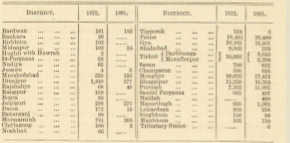Belbar
This article is an extract from
THE TRIBES and CASTES of BENGAL. Ethnographic Glossary. Printed at the Bengal Secretariat Press. 1891. . |
NOTE 1: Indpaedia neither agrees nor disagrees with the contents of this article. Readers who wish to add fresh information can create a Part II of this article. The general rule is that if we have nothing nice to say about communities other than our own it is best to say nothing at all.
NOTE 2: While reading please keep in mind that all articles in this series have been scanned from a very old book. Therefore, footnotes have got inserted into the main text of the article, interrupting the flow. Readers who spot scanning errors are requested to report the correct spelling to the Facebook page, Indpaedia.com. All information used will be duly acknowledged.
Belbar
One who works with a. bel, or hoe.' A wandering Dravidian caste of earth-workers and navvies in Behar and Western Bengal, many of whom are employed in the coal-mines of Raniganj and Barakar. Both men and women labour, the former digging the earth and the latter removing it in baskets carried on the head. The Beldars regard this mode of carrying earth as distinctive of themselves, and will on no account carry earth in baskets slung from the shoulders. They work very hard where paid by the piece, and are notorious for their skill in manipulating the pillars (srikhi, , witness ') left to mark work done, so as to exaggerate the measurement. On one occasion, while working for me on a large lake at Govindpur, in the no rtp of the Manbhum district, a number of Beldars transplanted an entire pillar during the night and claimed payment for several thousand feet of imaginary earthwork. Tho fraud was most skilfully carried out, and was only detected by accident. In Western Bengal they rank with Koras and Bauris, and, like them, are terribly addicted to drink. They profess to marry their daughters as infants, but the practice of adult-marriage still survives among them; while they certainly allow widows to remarry, and recognise considerable license of divorce. Divorced women may marry again.
Origin and internal structure
The origin of the caste is obscure. They are certainly closely akin to the Binds and Nunias, and it seems probable that the former represent the remnant of a compact aboriginal tribe, from which the Nunias broke off by taking to the manufacture of saltpetre, and the Beldars by going in for earthwork. The functions or the Binds are less specialised; and this circumstance, coupled with the fact that they reckon hunting and fishing among their characteristic occupations, leads me to regard them as the oldest of the three groups, and probably the parent of both Nunias and Beldars. The internal structure of the Beldars throws little light upon their tribal affinities. In Behar they have two sub-castes :-Chauhan and Kathautia or Kathawa, and one section, Kasyapa. Their marriages are regulated by the standard formula mamel'a, chache1"Ct, etc. Infant¬marriage is in vogue, and the marriage ceremony is of the standard type. A second wile may be taken if the first is barren. Widows many by sagai. Divorce by the caste panchayat is recognised, and divorced women may marry again.
Religion
Beldars employ Maithil Brahmans as their priests, and conform in matters of religion, funeral rites, etc., to the average Hinduism of the lower castes. On the Tila Sankrant festival, in Magh, they worship the Larlta, a pointed iron instrument used in pounding bricks-one of their standard occupations. A few of them are cultivators with occupancy rights : most, however, earn their living as names or as agricultural day-labourers. Their social rank is much the same as that of Nunias.
In treating of the Beldars much confusion is caused by the fact that the term BeIdaI', 'mattock-bearer,' besides denoting a distinct endogamous group, is also used as a generic title common to the low castes of Hindus employed on earthwork. This use of the word in its proper etymological sense, as denoting merely an occupation, comes out even more clearly in Eastern Bengal, where we find Mahomedan Beldars, who act as scavengers in their own villages, removing carcasses or cutting brushwood, and serve as torch-bearers (masalchi) at Hindu and Mahomedan weddings. The following statement shows the number and distribution of Beldars in 1872 and 1881, but the statistics are worthless by reason of the confusion in the use of the name explained in the last paragraph :¬
